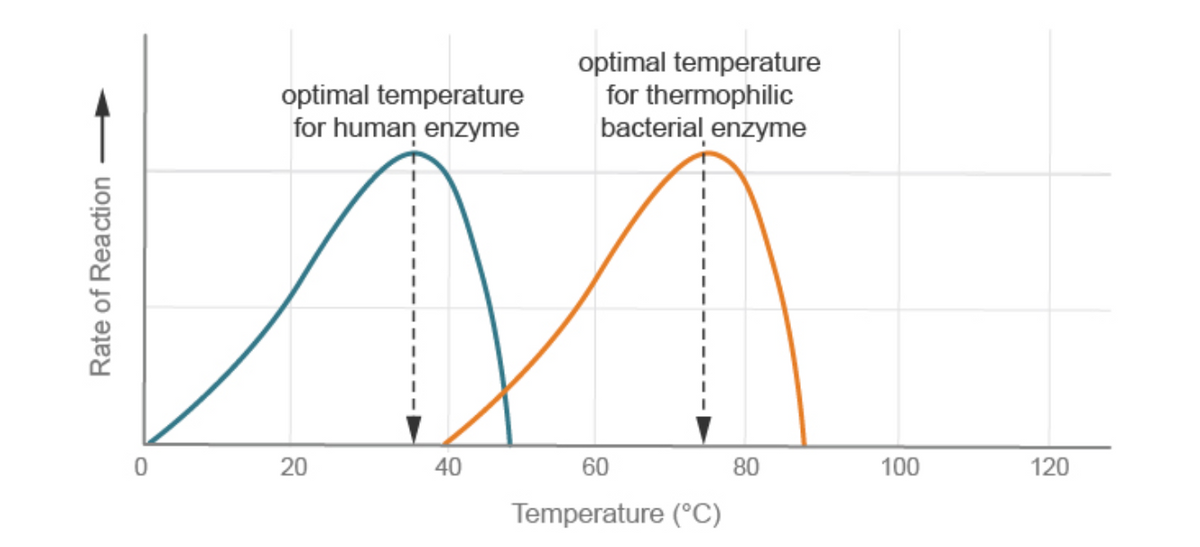Human enzymes have an optimal temperature of approximately 37°C, while thermophilic bacterial enzymes have an optimal temperature of approximately 75°C. Which of the following statements best explains the change in the rate of these enzymatic reactions between 40°C and 70°C? The rate of reaction of the human enzyme decreases as the reaction requires less energy to proceed, while the rate of the reaction of the thermophilic bacterial enzyme increases as the reaction requires more energy to proceed. The rate of reaction of the human enzyme decreases as the enzyme denatures, while the rate of the reaction of the thermophilic bacterial enzyme increases as molecules move faster, causing more collisions between the enzyme and substrate. The rate of reaction of the human enzyme decreases as the entire enzyme denatures, while the rate of the reaction of the thermophilic bacterial enzyme increases as only the active site of the enzyme denatures at higher temperatures, allowing for a tighter fit with the substrate.
Human enzymes have an optimal temperature of approximately 37°C, while thermophilic bacterial enzymes have an optimal temperature of approximately 75°C. Which of the following statements best explains the change in the rate of these enzymatic reactions between 40°C and 70°C? The rate of reaction of the human enzyme decreases as the reaction requires less energy to proceed, while the rate of the reaction of the thermophilic bacterial enzyme increases as the reaction requires more energy to proceed. The rate of reaction of the human enzyme decreases as the enzyme denatures, while the rate of the reaction of the thermophilic bacterial enzyme increases as molecules move faster, causing more collisions between the enzyme and substrate. The rate of reaction of the human enzyme decreases as the entire enzyme denatures, while the rate of the reaction of the thermophilic bacterial enzyme increases as only the active site of the enzyme denatures at higher temperatures, allowing for a tighter fit with the substrate.
Biomedical Instrumentation Systems
1st Edition
ISBN:9781133478294
Author:Chatterjee
Publisher:Chatterjee
Chapter6: Biomedical Electrodes, Sensors, And Transducers
Section: Chapter Questions
Problem 7Q
Related questions
Question
Human enzymes have an optimal temperature of approximately 37°C, while thermophilic bacterial enzymes have an optimal temperature of approximately 75°C. Which of the following statements best explains the change in the rate of these enzymatic reactions between 40°C and 70°C?
The rate of reaction of the human enzyme decreases as the reaction requires less energy to proceed, while the rate of the reaction of the thermophilic bacterial enzyme increases as the reaction requires more energy to proceed.
The rate of reaction of the human enzyme decreases as the enzyme denatures, while the rate of the reaction of the thermophilic bacterial enzyme increases as molecules move faster, causing more collisions between the enzyme and substrate.
The rate of reaction of the human enzyme decreases as the entire enzyme denatures, while the rate of the reaction of the thermophilic bacterial enzyme increases as only the active site of the enzyme denatures at higher temperatures, allowing for a tighter fit with the substrate.
The rate of reaction of the human enzyme decreases as the molecules move slower and fewer collisions occur between the enzyme and the substrate, while the rate of the reaction of the thermophilic bacterial enzyme increases as molecules move faster, causing more collisions between the enzyme and substrate.

Transcribed Image Text:optimal temperature
for human enzyme
optimal temperature
for thermophilic
bacterial enzyme
40
60
80
100
120
Temperature (°C)
Rate of Reaction
20
Expert Solution
This question has been solved!
Explore an expertly crafted, step-by-step solution for a thorough understanding of key concepts.
This is a popular solution!
Trending now
This is a popular solution!
Step by step
Solved in 4 steps

Knowledge Booster
Learn more about
Need a deep-dive on the concept behind this application? Look no further. Learn more about this topic, biology and related others by exploring similar questions and additional content below.Recommended textbooks for you


Biology: The Unity and Diversity of Life (MindTap…
Biology
ISBN:
9781337408332
Author:
Cecie Starr, Ralph Taggart, Christine Evers, Lisa Starr
Publisher:
Cengage Learning

Biology: The Unity and Diversity of Life (MindTap…
Biology
ISBN:
9781305073951
Author:
Cecie Starr, Ralph Taggart, Christine Evers, Lisa Starr
Publisher:
Cengage Learning


Biology: The Unity and Diversity of Life (MindTap…
Biology
ISBN:
9781337408332
Author:
Cecie Starr, Ralph Taggart, Christine Evers, Lisa Starr
Publisher:
Cengage Learning

Biology: The Unity and Diversity of Life (MindTap…
Biology
ISBN:
9781305073951
Author:
Cecie Starr, Ralph Taggart, Christine Evers, Lisa Starr
Publisher:
Cengage Learning